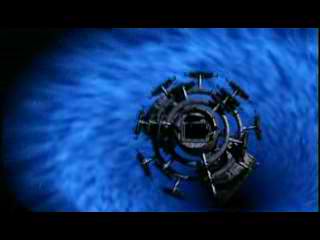 HYPERSPACE JUMP ENGINES
Model: Hyperspace Jump Engines
Type: Hyperspace entry/exit FTL travel device
Scale: Capital
Skill: Astrogation, Capital ship piloting
Cost: 30,000 credits on average plus installation costs
Weight: 30 metric tons
Availability: 1, R
GAME NOTES:
-OPERATIONS: Using hyperspace jump-point engines in the Babylon 5 setting is different that using hyperdrives in Star Wars (for more on this, see below). Ships with their own jump-point engines are usually big (capital scale), and these engines require a lot of power to use. As such, when activating jump engines, a ship cannot use weapons or maneuver (they can, however, continue their momentum moving forward, such as trying to open a jump-point in front of the ship and gliding into the opening while staying in motion). After the jump-point is open, the ship must then use an action and round to maneuver into the hyperspace opening. This can leave a ship vulnerable to attack while attempting to do so. After using their jump engines, a ship then needs to recharge these engines before using them again. In most ships, this commonly takes one minute (10 rounds), though some species' ships may take more or less time. More advanced ships, such as Minbari capital vessels, White Stars, ISA destroyer class White Stars, and the EA Warlock destroyers, all are able to open jump-points, still use their weapons, and open jump-points again within a round or 2 after the first opening.
-SKILLS: To open/close a jump-point, use Capital ship piloting. To navigate through hyperspace, use Astrogation.
-JUMPGATE EXPLOSION: Sometimes a capital ship's own jump-point can be attacked and destabilised to collapse while a ship is in or near the event horizon of the opening. If this happens, the collapsing gate causes 14D Damage (the general idea being that the massive energy in a jump-point would destroy most ships). A ship's jump engines could also be used to cause a massive explosion in another jump-point (see Hyperspace Jumpgate for more details).
DESCRIPTION:
While hyperspace jumpgates are a very common site in the interstellar community in Babylon 5, and are very expensive to create and operate, it is possible to build ships with hyperspace jump-point engines of their own. Unlike jumpgates, the jump engines for ships can be a massive drain on a their power reserves, and can be hazardous to use when in the middle of a space battle. For this reason and others, even ships equipped with jump engines prefer to use stationary jumpgates whenever possible as a means of conserving power, as well as giving themselves the chance to use their own jump engines to leave quickly if something bad should happen.
But for a few exceptions, ships with their own jump-point engines must be capital scale, and these must be of the larger capital scale. Smaller/lighter capital ships usually don't have the space or power output to equip and use a hyperspace jump-point engine. This is usually reserved for military vessels as well. Other ships are restricted to using hyperspace jumpgates.
The exceptions to this general rule start with the White Star, a lighter and smaller Minbari vessel (though dubbed a "medium cruiser") built with combined Minbari and highly advanced Vorlon technoloies, it was the first known ship of its size that could open its own jump-points. After the Shadows and Vorlons departed the galaxy and with the creation of the Interstellar Alliance, this design was put to further use in future ISA ships. Eventually, over the course of twenty years, the ISA were able to build much smaller ships that could open their own jump-points, such as the Blue Star, aka Snub-Nose White Star, a starfighter scale space transport with all the technologies of a White Star in a much smaller package.
Jump-Point Engines VS Hyperdrives
Hyperspace jump-point engines from Babylon 5 and hyperdrives from Star Wars share some similarities, but also have some big differences.
For similarities, they both allow the greater galactic community to travel faster than light and indulge in interstellar trade, commerce, travel and politics. They both also allow ships to access another dimension of sorts in order to achieve this FTL travel. This is about where the similarity ends.
In Star Wars, the speed of travel through hyperspace depends on how
powerful the hyperdrive is. A ship could have slow speed in normal
space but travel faster than most ships in hyperspace, or the reverse
could be true. In Babylon 5, the speed a ship travels through
hyperspace depends on its own thrust propulsion to propel it, just as in
normal space.
In Star Wars, hyperdrives usually keep a ship in hyperspace as long as they are active, often dumping the ship back into normal space if it fails for some reason. Any stellar body that has gravity also has a presence in hyperspace and can damage or destroy any ship passing through these gravity well hazards.
In Babylon 5, once a ship enters hyperspace, it stays there until it uses another jump-point (either its own, another ship's, or that of a stationary jumpgate) to reenter normal space. Hyperspace in B5 does not have anomalies and hazards created by gravity wells in normal space, though it does have other hazards.
In Star Wars, hyperspace is pretty straightforward, even though sometimes certain hazards are mentioned, or some kind of anomaly causes problems with hyperspace, such as the barrier around the galactic Outer Rim, the barrier bisecting the galaxy, or such stellar phenomenon like the Kathol Rift, The Maw or The Maelstrom. But these are usually more for setting flavor and not often dealt with in game terms as long as players make their Astrogation skill rolls.
In Babylon 5, hyperspace requires the use of special beacons to navigate through it and find one's way across the hyperspace beacon network in order to safely travel from one point to another. Hyperspace also has waves and tides, and if a ship ever loses the beacon signal or loses its own propulsion while in hyperspace, there is a very good chance that these waves will move the ship too far away from the beacon network and the established trade routes that it will never be found. Except for one occassion in the Babylon 5 series, no rescue mission in hyperspace ever ended well.
In Star Wars, so far as anyone knows, nothing really lives in Hyperspace. In B5, during the Crusade series, it was revealed that there were large, capital scale lifeforms living in hyperspace, and they even like to hump ships that pass by. Also along these lines, in Star Wars, ships cannot "wait" in hyperspace such as to pass the time or stage an ambush, but must make the jump from one point or another and are in constant use during this trip, and having an "emergency stop" can cause damage to a ship or its hyperdrive. In B5, ships can do this, and often do as part of military tactics, and their jump-point engines are only used when entering/exiting hyperspace, not constantly to remain in hyperspace.
In Star Wars, no other spacial dimensions like hyperspace are readily known, though there are other dimensional universes and parallel realities such as Otherspace, the native dimension of the horrid charon. In Babylon 5, other dimensions such as this were found, like "Third Space" with its own evil conquering powerful species, while also other dimensions for travel have been discovered, such as Quantum Space, which allows travel at twice the speed of hyperspace.
In Star Wars, Astrogation is used to navigate hyperspace travel courses from one point to another while avoiding certain obstacles and hazards like stellar body gravity wells. In Babylon 5, Astrogation is used to navigate between hyperspace beacons to locate safe areas in hyperspace to revert back to normal space. Astrogation can also be used to overcome and correct for hyperspace anomalies, like the eb and flow of the waves and tides of distortion in hyperspace that can make navigation and flight more difficult. In some ways, Astrogation is more important in B5 than in Star Wars, but the result is the same: make a skill roll to get from one place to another.
In Star Wars, hyperspace has no effect on Force users much, though there have been artifacts and objects that have links with hyperspce and the Force. Hyperspace also can deliver massive amounts of radiation to a ship and its crew, which is why ships keep their shields up when traveling through hyperspace, or have some other method of protection. In Babylon 5, hyperspace may have some forms of radiation, but this is no where nearly as prevelant, and telepaths in hyperspace have their abilities magnified from the effects of hyperspace.
|












